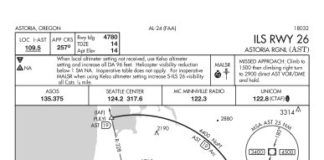Cleared … How?
Regarding “Cutting You Loose” in the July issue, I’ve never actually been cleared by ATC with “Proceed on course,” after an off-route vector. When faced with this situation, I either got cleared present position to next waypoint or a vector back to the airway I’d left. As you said, anything vague or unclear should be clarified.
Your magazine always promotes thought. Thank you.
Ken Daidone
Farmington, CT
Well, Ken, consider yourself lucky that you’ve never encountered any controller who used that informal and imprecise phraseology. While it’s not pervasive, it is common. We’ve gotten it many times. Now, with Tarrance’s article, hopefully enough of us will begin to question it in the future, that it’ll fade away.
Amusing Typos
In your August issue, the ATC article, “COVID-19 Lessons” on Page 12 has the tag at the top preceding the author’s name, saying “ATC Notbook.”
Barry McCollom
Kerrville, TX
Yah, w bn maning to gt that ky fixd on
our kyboard.
There is a delightful typo in the November Readback letter from Paul Lehman. It says “So if the pilot over speeds, underspends, or over banks, the autopilot will automatically correct.”
We know flying is expensive, so it’s good to know the autopilot will take charge if we underspend!
Love the mag. Keep the great articles
coming.
Chris Conte
Fuquay Varina, NC
You’ve heard of “ fortune cookies,” fun little items hidden in some serious computer program? Well, we’d like to say this was a fortune cookie we hid in Readback, but wouldn’t be true.
Good catch, Chris. At least it provided a chuckle. Thanks.
Where’s the Master Pilot?
I read your Remarks column (October 2020) about the Wright Brothers Master Pilot award with interest.
I’ve been a pilot for 52 years and think that I might be eligible but I was not able to find anything about this on the FAA’s website. Perhaps you could help out by printing a specific url.
Rod Dykhouse
Templeton, CA
It’s not under the FAA main site, but is administered under the WINGS program. A quick search of the web for “Wright Brothers Master Pilot Award”
yielded this result: https://www.faasafety.gov/content/ MasterPilot/
(Almost) Updated AIM
In July last year we published “Deep Dive into Mins,” which discussed a change i the AIM that permitted without endorsing circling at a higher speed than the mins category. Multiple readers consulted their handy 2020 printed copy of the AIM and didn’t see the change. Some even went so far as to suggest we were making this stuff up. A bit later, we got this note from one of those readers.
Recently, I responded to the October 2020 Readback item, “Mins Deep Dive Deep Thought.” I wondered if you’d made up the stuff you wrote about because it wasn’t in my most-up-to-date copy (2020) of the AIM.
I just received my new copy of the 2021 AIM and I stand corrected. The change you discuss is in there. I do have a recommendation, though. It would be very helpful if in the future your discussions of recent changes would cite the year.
I graduated from Army Flight School in 1969, flew helicopters in the Army for 31 years, and presently teach instruments and emergency procedures at the Simulator Division at Fort Bliss, Texas. I read your magazine every month; it has by far made me a better instructor, and I thank you for that.
Lawrence Davidian
Ft. Bliss, TX
Thank you for your follow-up note, Lawrence. Actually, the AIM is updated by the FAA multiple times a year, so the printed versions that come out annually
just can’t keep up. You can always download the latest AIM changes or the entire AIM from the FAA website.
We did note in the original article that we were discussing the latest update, one that had only come out a couple months before. But, the lesson to us as authors and editors is that when we’re referencing a recent change, we must identify the date of that change and point out the frequency of updates, and that this update isn’t likely in any printed versions of the AIM. In fact, it probably would be a good idea if the articles included a link to the latest changes.
Either Way, That’s Cold
Question #12 on the November Quiz actually has two incorrect statements. (You asked for one.) Choice d. is also incorrect. AIM paragraph 5-1-17 has always stated that corrections are required when the temp is “at or below.”
Roger Harris
Stockton, NJ
Yeah, okay, but…Choice d. is still correct; corrections are required with an OAT below 31-degrees C. It’s just that they’re also required at 31-degrees C.
Intercept Confusion
I have a couple questions about the approach that you featured in your October Killer Quiz:
1) After TOURO it looks as though you head 146 degrees until reaching the 279 radial of STT. Then you turn left to intercept the localizer. Why is no heading indicated for the intercept? Unless you’re following the ubiquitous magenta line on your GPS or get vectored by ATC, it looks like you just guesstimate what turn you need to go from a 146 to a 100 heading.
2) The note after TOURO indicates the 146 heading and a 2800 foot altitude, but what do the numbers 13.2 and 7 represent? I assume they’re a distance, but from what to what?
3) The 279 radial off STT is indicated as LR-279 and not just R-279. What’s the significance of the L?
Thanks for any help on this rather confusing, to me at least, chart.
Gerald Weigle
Cincinnati, OH
1) It’s extremely uncommon for an intercept heading to be shown on any approach chart. However, it is common for “lead radials” to be depicted. Look at most any approach with a DME arc to final and you’ll see those “LR” notations, showing the lead radial. Lead radials are widely discussed in texts, but essentially they mark the point at which a highspeed aircraft would begin a turn to the next course. Further, note that you’re not on a heading from TOURO; you’re on the COY 326 radial. On that radial, it’s 13.2 miles until the localizer, then 7 miles to KUTHO. Yes, whenever you’re flying solely with VHF nav there’s a lot of experience, some calculations, and some guesswork in determining your intercept of the next course.
2) Those numbers are distances, as explained above. The parenthetical distance notation is common on government approach charts, such as the ninemile notation from STT to KUTHO.
3) “LR-279” is the lead radial, as explained above. This depiction here might be a little confusing as the lead radial is from the STT VOR not from the localizer. (Of course, on careful thought, it couldn’t be from the localizer since you don’t get radials from a localizer. Another hint is that the lead radial is 279, depicted north of the 280-degree localizer when it would be south if from the same source.)





